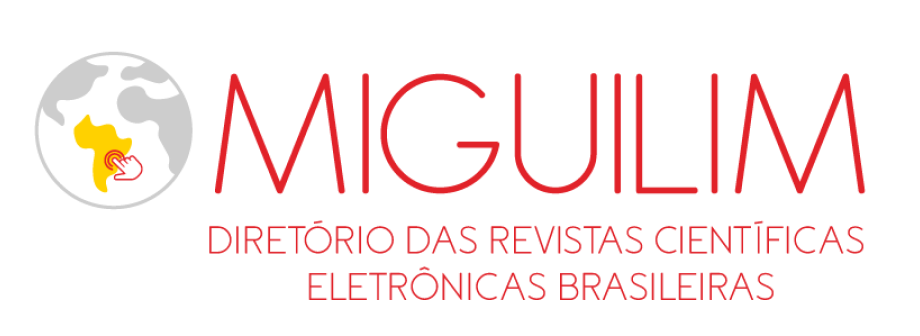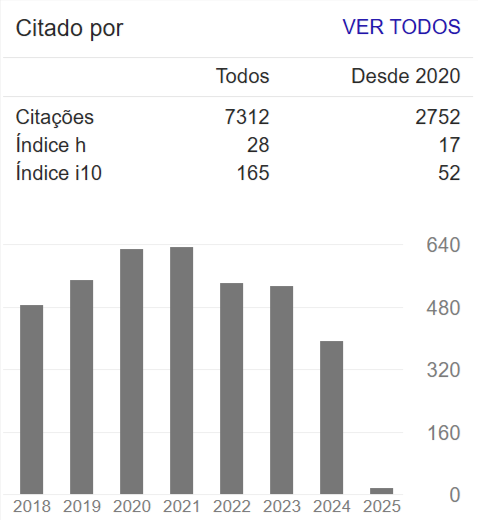Hydrogeochemical Processes and Groundwater Evolution of the Crystalline Aquifer of Amargosa Sheet, SD.24-VD-II, South-Central of Bahia
Abstract
Hydrogeochemical investigations were carried out in order to identify the processes that affect the chemistry of groundwater in the south-central region of Bahia that comprises the Amargosa sheet. Forty-nine hydrochemical analysis of representative wells in the area were used and their results interpreted according to the chemistry of the major ions, using conventional and bivariate graphs. There is a wide range of hydrochemical facies, with mixed cationic species (Ca-Na + K) and Cl- and HCO3- predominating as the dominant anionic facies. In general, HCO3- facies occur in regions of sub-humid climate and active flow while the Cl- facies occurs in semi-arid conditions and slow flowlines. The mechanisms of water-rock interaction and evaporation are the main hydrogeochemical processes that control the chemistry of groundwater, with an emphasis on the weathering of silicates (plagioclases, pyroxenes and biotite); chlorine-alkaline imbalance, common in HCO3 facies and cation exchange reaction, representative of Cl facies. Therefore, this work contributes to fill gaps and present contextual information about the processes that control the geochemical signature of the crystalline aquifer and possible variations in the quality of groundwater, in order to raise the knowledge of a complex system and establish the basis for a more rational exploration of anisotropic aquifers.
References
ALMEIDA, F.F.M. Diferenciação tectônica da plataforma brasileira. In: CONGRESSO BRASILEIRO DE GEOLOGIA, 23, 1969. [Anais...]. Salvador. 1969. p. 29-46.
ALMEIDA, F.F.M. O Cráton do São Francisco. Revista Brasilei-ra de Geociências,7, p. 349-364, 1977.
ALY, A. A. Hydrochemical characteristics of Egypt western de
sert oases groundwater. Arabian Journal of Geosciences, v. 8, n. 9, p. 7551-7564, 2014. https://doi.org/10.1007/s12517-014-1680-8
EATON, A. D.; CLESCERI, L. S.; GREENBERG, A. E.; FRANSON, M. A. H. Standard methods for the examination of wa-ter and wastewater. 19th ed. Washington, DC: American Public Health Association (APHA), 1995.
AYENEW, T.; DEMLIE, M.; WOHNLICH, S. Hydrogeological framework and occurrence of groundwater in the Ethiopian aquifers. Journal of African Earth Sciences, v. 52, p. 97–113, 2008. https://doi.org/10.1016/j.jafrearsci.2008.06.006
BARBOSA, J. S. F.; SABATÉ, P. Geological features and the Paleoproterozoic collision of four Archean crustal segments of the São Francisco Craton, Bahia, Brazil: a synthesis. Anais Da Academia Brasileira de Ciências, v. 74, n. 2, p. 343–359, 2002.https://doi.org/10.1590/s0001-7652002000200009
BARBOSA, J.S.F.; SABATÉ, P. Colagem paleoproterozóica de placas arqueanas do Cráton do São Francisco na Bahia. Revista Brasileira de Geociências, v. 33, n. 1(Suplemento), p.7-14, 2003.
BARBOSA, J.S.F.; SABATÉ, P. Archean and Paleoproterozoic crust of the São Francisco Craton, Bahia, Brazil: geodynamic features. Precambrian Research 13:1–27, 2004.
BARBOSA, J.; NICOLLET, C.; LEITE, C.; KIENAST, J.; FUCK, R.; MACEDO, E. Hercynite–quartz-bearing granulites from Brejões Dome area, Jequié Block, Bahia, Brazil: Influence of charnockite intrusion on granulite facies metamorphism. Lithos, v. 92, n. 3-4, p. 537–556, 2006. https://10.1016/j.lithos.2006.03.064
BRASIL. Ministério das Minas e Energia. Secretaria Geral. Projeto Radam Brasil: folha SD. 24 Salvador: geologia, geo-morfologia, pedologia, vegetação, uso potencial da terra. Rio de Janeiro. v. 24, 1981. 620 p. (Levantamento de Recursos Naturais, 24).
BRASIL. Ministério da Saúde. Portaria GM/MS nº 888, de 04 de maio de 2021 - Altera o Anexo XX da Portaria de Consoli-dação GM/MS nº 5, de 28 de setembro de 2017, para dispor sobre os procedimentos de controle e de vigilância da quali-dade da água para consumo humano e seu padrão de pota-bilidade. Diário Oficial da União, 2021. https://www.in.gov.br/en/web/dou/-/portaria-gm/ms-n-888-de-4-de-maio-de-2021-318461562
CHADHA, D. K. A proposed new diagram for geochemical classification of natural waters and interpretation of chemi-cal data. Hydrogeology Journal, v. 7, n. 5, p. 431–439, 1999. https://doi.org/10.1007/s100400050216
CRUZ, S. C. P.; LEAL, A. B. M.; DAMASCENO, G. C.; PALMEIRA, D. S. Carta geológica: folha Amargosa - SD.24-V-D-II. Salva-dor: CPRM. Escala 1:100.000, 2014. http://rigeo.cprm.gov.br/jspui/handle/doc/18290
DOMENICO, P.A.; SCHWARTZ, F.W. Physical and chemical hydrogeology. Wiley, New York, p 824, 1990.
DUROV, S. A. Natural waters and graphical representation of their composition. Dokl. Akad. Nauk. USSR 59,87-90, 1948.
ELANGO, L.; KANNAN, R. Chapter 11 Rock–water interaction and its control on chemical composition of groundwater. Developments in Environmental Science, p. 229–243, 2007. https://doi.org/10.1016/s1474-8177(07)05011-5
FORNARI, A.; BARBOSA, J. S. F. Litogeoquímica do Batolito Enderbítico- Cranockítico do Complexo Jequié, na região de Laje e Mutuipe, Bahia. Rev Bras Geoc, v. 24, n. 1, p. 13-21, 1994.
GIBBS, R. J. Mechanisms Controlling World Water Chemistry. Science, v. 170, n. 3962, p. 1088–1090, 1970.
https://doi.org/10.1126/science.170.3962.1088
GIRIDHARAN, L.; VENUGOPAL, T.; JAYAPRAKASH, M. Evalua-tion of the seasonal variation on the geochemical parame-ters and quality assessment of the groundwater in the prox-imity of River Cooum Chennai India. Environ Monit Assess, v. 143, p. 161–178, 2008. https://doi.org/10.1007/s10661-007-9965-y
GULER, C. THYNE, G.D. Hydrologic and geologic factors con-trolling surface and groundwater chemistry in Indian Wells–Owens Valley area southeastern California USA. J Hydrol v. 285, p. 177–198, 2004.
https://doi.org/10.1016/j.jhydrol.2003.08.019
INSTITUTO BRASILEIRO DE GEOGRAFIA E ESTATÍSTICA (IB-GE). Mapa de Clima do Brasil. Rio de Janeiro: IBGE. Escala 1:5.000.000, 2002.
JALALI, M. Chemical characteristics of groundwater in parts of mountainous region, Alvand, Hamadan, Iran. Environmen-tal Geology, v. 51, n. 3, p. 433–446, 2006.
https://doi.org/10.1007/s00254-006-0338-6
JALALI, M. Geochemistry characterization of groundwater in an agricultural area of Razan, Hamadan, Iran. Environmental Geology, v. 56, n. 7, p. 1479–1488, 2008.
https://doi.org/10.1007/s00254-008-1245-9
KEBEDE, S.; TRAVI, Y.; ALEMAYEHU, T.; AYENEW, T. Ground-water recharge, circulation and geochemical evolution in the source region of the Blue Nile River, Ethiopia. Applied Geo-chemistry, v. 20, n. 9, 1658–1676, 2005.
https://doi.org/10.1016/j.apgeochem.2005.04.016
KIM, M. J.; NRIAGU, J.; HAACK, S. Carbonate ions and arsenic dissolution by groundwater. Environmental Science & Tech-nology, v. 34, p. 3094-3100, 2000.
https://doi.org/10.1021/es990949p
KINZELBACH, W.; BRUNNER, P.; VON BOETTICHER, A.; KGOTLHANG, L.; MILZOW, C. Sustainable water management in arid and semi-arid regions. In: WHEATER, H.; MATHIAS, S.; LI, X. (Eds.). Groundwater Modelling in Arid and Semi-Arid Areas. Cambridge: Cambridge University Press, 2010. P. 119-130. https://doi.org/10.1017/CBO9780511760280.009
KUMAR, P. J. S. Evolution of groundwater chemistry in and around Vaniyambadi Industrial Area: Differentiating the natural and anthropogenic sources of contamination. Chemie Der Erde - Geochemistry, v. 74, n. 4, p. 641–651, 2014. https://doi.org/10.1016/j.chemer.2014.02.002
KUMAR, H.; SAINI, V.; KUMAR, D.; CHAUDHARY, R.S. Influence of trisodium phosphate (TSP) anti-salant on the corrosion of carbono steel in cooling water systems. Indian J Chem Tech-nol v. 16, p. 401–410, 2009.
MACDONALD, A.M.; BONSOR, H.C.; DOCHARTAIGH, B.É.Ó.; TAYLOR, R.G. Quantitative maps of groundwater resources in Africa. Environ. Res. Lett. 7, 024009, 2012. https://doi.org/10.1088/1748-9326/7/2/024009
MACEDO, E. P. Petrografia, litogeoquímica, metamorfismo e evolução geotectônica dos granulitos das regiões de Amar-gosa, Brejões, Santa Inês, Jaguaquara e Itamari, Bahia, Bra-sil. Tese (Doutorado em Geologia) – Instituto de Geociên-cias, Universidade Federal da Bahia. Salvador, p. 336,
MAHMOUDI, N.; NAKHAEI, M.; PORHEMMAT, J. Assessment of hydrogeochemistry and contamination of Varamin deep aquifer, Tehran Province, Iran. Environmental Earth Scienc-es, v. 76, n. 10, 2017. https://doi.org/10.1007/s12665-017-6698-2
MATTHESS, G. The properties of groundwater. Wiley, New York, p 498, 1982.
MONDAL, N. C.; SINGH, V. P.; SINGH, V. S.; SAXENA, V. K. Determining the interaction between groundwater and sa-line water through groundwater major ions chemistry. Jour-nal of Hydrology, v. 388, n. 1-2, p. 100–111, 2010. https://doi.org/10.1016/j.jhydrol.2010.04.032
PIPER, A. M. A graphic procedure in the geochemical inter-pretation of water-analyses. Transactions, American Geo-physical Union, v. 25, n. 6, p. 914, 1944.
https://doi.org/10.1029/tr025i006p00914
SCANLON, B.R.; KEESE, K.E.; FLINT, A.L.; FLINT, L.E.; GAYE, C.B.; EDMUNDS, W.M.; SIMMERS, I. Global synthesis of groundwater recharge in semiarid and arid regions. Hydrol. Process. V. 20, p. 3335–3370, 2006.
https://doi.org/10.1002/hyp.6335
SCHOELLER, H. Geochemistry of groundwater. An interna-tional guide for research and practice. UNESCO, cap. 15, p 1–18, 1967.
SIVASUBRAMANIAN, P.; BALASUBRAMANIAN, N.; SOUNDRA-NAYAGAM, J. P.; CHANDRASEKAR, N. Hydrochemical charac-teristics of coastal aquifers of Kadaladi, Ramanathapuram District, Tamilnadu, India. Applied Water Science, v. 3, n. 3, p. 603–612, 2013.
https://doi.org/10.1007/s13201-013-0108-z
SRINIVASAMOORTHY, K.; CHIDAMBARAM, S.; PRASANNA, M. V.; VASANTHAVIHAR, M.; PETER, J.; ANANDHAN, P. Identifica-tion of major sources controlling groundwater chemistry from a hard rock terrain — A case study from Mettur taluk, Salem district, Tamil Nadu, India. Journal of Earth System Science, v. 117, n. 1, p. 49–58, 2008. https://doi.org/10.1007/s12040-008-0012-3
SULTAN, M.; YAN, E.; STURCHIO, N.; WAGDY, A.; GELIL, K.A.; BECKER, R.; MANOCHA, N.; MILEWSKI, A. Natural discharge: A key to sustainable utilization of fossil groundwater. J. Hy-drol. v. 335, p. 25–36, 2007. https://doi.org/10.1016/j.jhydrol.2006.10.034
TOUMI, N.; HUSSEIN, B. H. M.; RAFRAFI, S.; EL KASSAS, N. Groundwater quality and hydrochemical properties of Al-Ula Region, Saudi Arabia. Environmental Monitoring and As-sessment, v. 187, n. 3, 2015.
https://doi.org/10.1007/s10661-014-4241-4
UMAR, A.; UMAR, R.; AHMAD, M.S. Hdrogeological and hydro-chemical framework of regional aquifer system in KaliGanga sub-basin India. Environ Geol, v. 40, n. 4–5, p. 602–661, 2001. https://doi.org/10.1007/s002540000215
WORLD HEALTH ORGANIZATION (WHO). Guidelines for drink-ing-water quality. 4. ed. Geneva, 2011.
YOUSIF, M.; EL-AASSAR, A. H. M. Rock-water interaction pro-cesses based on geochemical modeling and remote sensing applications in hyper-arid environment: cases from the southeastern region of Egypt. Bulletin of the National Re-search Centre, v. 42, n. 1, 2018.
https://doi.org/10.1186/s42269-018-0004-7
ZAKI, N.A.; HAGHIGHI, A.T.; ROSSI, P.M.; TOURIAN, M.J.; KLØVE, B. Monitoring Groundwater Storage Depletion Using Gravity Recovery and Climate Experiment (GRACE) Data in Bakhtegan Catchment, Iran. Water, v. 11, n. 1456, 2019. https://doi.org/10.3390/w11071456

















